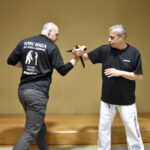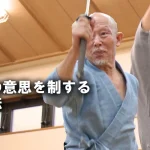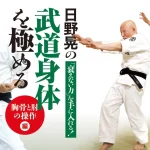Ground Zero “Okinawa karate has spread from its birthplace to the entire world”
 It is well-known that Okinawa is the source of Karate. Its popularity has crossed seas and oceans and has attracted millions of people from all over the world.
It is well-known that Okinawa is the source of Karate. Its popularity has crossed seas and oceans and has attracted millions of people from all over the world.
In this special Okinawa edition, we are meeting with Daniel Mardon, who is a long time Shotokan karate practitioner, a renowned physical therapist and the author of several books. He is visiting today the “Suimeikan Dojo” in Awase (Okinawa City). The Master is Hanshi Kiecho Tobaru; an expert in Uechi-Ryu, who is also the Vice Chairman of “Okinawa Karate Project Committee”.
A Japan-France Karate exchange is taking place here, between a leader of the Okinawan karate world and a blue-eyed karateka!
Tobaru Keicho
Uechi-Ryu Hanshi 9th Dan, Tobaru Sensei was born in Okinawa in 1944. He is also the president of the Okinawa Karatedo Association. Tobaru Sensei started Karate in 1965, when he was a first-year student at the University of the Ryukyus. He joined the famous Futenma Dojo, which was run by Uechi Kanei, the son of the founder and devoted himself to intense training. In 1996, he established Awase Suimeikan. Through teaching karate and Ryukyu kobudo, Tobaru Sensei strives to preserve, to pass on, and to spread Okinawan karate. His aim is to also promote international exchanges and to contribute to a healthy education for young people.
Daniel Mardon
Creator of Aromapressure® method and physiotherapist with a valid US license, Daniel Mardon was born in Paris. One of his specialties is to teach and to perform lymphedema and subcutaneous tissue-damage care, after radiotherapy for cancer patients at medical institutions and subcutaneous tissue-circulation stimulation before and after surgery.
He was also a therapist for two famous soccer teams in Paris. Since 2005, he has focused on producing top-class hotel spas in Japan, as well as physiotherapy education and awareness-raising activities for health care professionals. Author of several books, among his major publications includes “The Physiology and Bodywork of Physical Therapy ” (Published by BAB Japan) and DVD “Daniel Mardon Aromapressure® Method ” (Pony Canyon). He regularly appears on television and radio shows, and has featured in numerous media publications.
Okinawa is karate ground zero
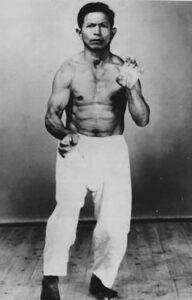
Kanei Uechi, the second generation of Uechi-Ryu, who has an amazingly trained body.
──Daniel Sensei, you have been practicing karate at a high level and for a long time, in various countries around the world, including Europe, Africa, the United States and Japan. You are now continuing to share your passion for karate from its source.
First of all, please tell us about the karate situation overseas.
-DANIEL SENSEI European Karate is very connected to mainland-Japan Karate. Especially in France, where the first European Dojo opened in Paris in 1953. France had a tradition to bring young Japanese expert instructors. Most came from Tokyo Universities and several of them have lived and have spent their entire lives in France!
This is the reason why I found out that Japanese karate is so much like the one we have and it made me feel like home when I came to Tokyo. On the contrary, this was absolutely not the case with Okinawa, where I discovered a very different Karate!
In terms of Karate-sport and competition, France currently ranks second right after Japan and has won a total of 38 world titles since 1970.
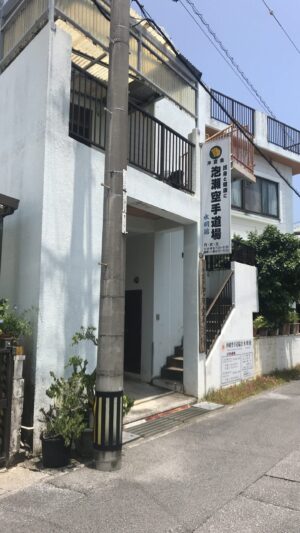
Awase Suimeikan which was established in 1996 by Master Tobaru.
-TOBARU SENSEI In France, sports are under the control of the government and are therefore managed nationally. That is why the level of karate is very high. Uechi-Ryu is a rare style in France, but we have many students in Argentina, Bolivia and Brazil. I think that the overall level is one step lower than the one in France.
The Shotokan school, which is the main style of Daniel sensei, was first introduced to France from Mainland-Japan. That is why the Shotokan style is still mainstream in France.
Okinawa-styles practitioners represent merely 10% of the French Shotokan Karateka.
-DANIEL SENSEI It is true that when I started Karate; about 48 years ago, most of the karate was either Shotokan or Wado-Ryu. The reason was that we only had experts from those styles! However, France has recently opened towards Okinawa and Kobudo and Okinawan styles are increasing.
Due to the historical context, American karate is a bit older and very connected to Okinawa and less to Mainland Japan compared to Europe (I wrote a lot about Karate history).
-TOBARU SENSEI This opening from France makes me happy!
In order to deal with the current situation, we will use the “Okinawa Karate Kaikan”, which was established in 2017, as a center for transmission of Okinawan styles. With its popularity, Okinawa styles will catch up with Shotokan.
Before the Karate Kaikan was built, we only had small dojos all over Okinawa. This was the only way for Okinawa Karate to make connections with other countries. The Karate Kaikan is trying to federate, control and unite them. However, I think even very small dojos should never be lost. They are the core of our traditional culture. There is no Okinawa karate without individual dojos.
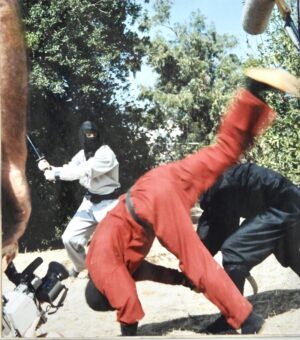
When he was an actor, Daniel Sensei was selected as a member for Sho Kosugi’s Ninja team (He is the one standing with the Ninja-to忍者刀).
-DANIEL SENSEI Okinawa is indeed the birthplace of karate, and after 37 years of practicing and “soaking” into the world of karate, I finally discovered the true Okinawa karate when I moved to Okinawa 11 years ago.
After 11 years of total immersion, I can still find a bunch of “secret Dojo”; sometimes in the most unexpected places. I believe there are about 300 Dojo throughout Okinawa and just on this island!
Even now, when I discover a new Dojo and I open the door for the first time, I am deeply moved by the imprint of its history. It is a very special feeling, like a “Time travel”. All the dojo that I have visited will be engraved in my heart and will never be forgotten. This was my dream as a French Karate boy! Each dojo is like a sacred place and the teachers are very gentle, wonderful, and humble. It is difficult to express this feeling with simple words.
-TOBARU SENSEI The famous saying, “There is no first strike in karate,” has been spread around the world from Okinawa. This spirit still remains in Okinawa.
The essence of Uechi-Ryu “Ganseishushou”
──Tobaru Sensei, you should be called a super Master, both in Uechi-Ryu and by extension, to the Okinawan karate world. What do you believe is the essence of Uechi-Ryu?
-TOBARU SENSEI In Uechi-Ryu, there is a saying, 眼精手捷Ganseishushou.
The meaning is that you should observe with sharp eyes and move your limbs quickly to win over your opponent.
Even when performing a kata, we perform it quickly and without unnecessary slowdowns. Therefore, we don’t use much pauses at the end of a technique.

The Shotokan style that Daniel Sensei trained for many years was founded by Gichin Funakoshi, the “father of modern karate,” and is characterized by dynamic and speedy movements.
──Shotokan-Ryu is also characterized by dynamic and fast movements, but is the “speed” sought by Uechi-Ryu different from that?
-TOBARU SENSEI I think it’s the same in terms of seeking speed in techniques. However, in Uechi-Ryu, even in a Kata, there is no “freezing” after a punch or any stroke. Once the strike is made, we immediately pull back and we move to the next technique.
In addition, the speed of Uechi-Ryu comes from 体鍛えtaigitae; which means “training the body to get hit”.
We train all parts of the body that can be trained, especially the arms and the legs that are used as weapons, but also the torso, because it often gets hit. Thus, we are confident that we will be able to endure getting hit.
We are therefore more prone to take risks and sometimes we let ourselves get hit to provoke an opening. If you have a body that is trained in this manner, you will not be afraid of the opponent’s counterattacks and this will lead to more concentration and relaxation for better speed in your attacks. This is one of the secrets for speed!

<Sanchin kitae (training)>
The basics of physical conditioning in Uechi-Ryu is to perform “Sanchin” kata, while being hit in every part of the body (left). The body becomes strong enough and can handle the breaking of a heavy square wooden stick (right).
──It’s really amazing that someone over the age of 70, like Tobaru-Sensei, is still able to do such intense training.
-TOBARU SENSEI Of course, there are some body-parts that decline with age, but the benefit of years of training compensates and allows us to deal with it.
-DANIEL SENSEI Yes, continuing karate training after getting old maintains the body in a good condition and prevents aging. Also, the nervous system keeps its reflexes as sharp as they were years ago. Well done, Karate is one of the best workouts for mental and physical health. Moreover, Karate brings a plus with its unique concept of invincibility. Karate offers, for a lifetime, the great feeling of having a stronger mind and a stronger body.
──Tobaru sensei, you directly studied under Uechi Kanei Sensei, who is the son of Uechi Kanbun; the founder of Uechi-Ryu! What was your impression of him?
-TOBARU SENSEI The impression that there is no other karateka with such a well-trained body. It was scary to see how he could move so sharply and fast, with such a tremendous muscular body. I remember that all the dojo students were training hard, hoping to develop a body like that.
A strike that pierces rather than just impacts a surface
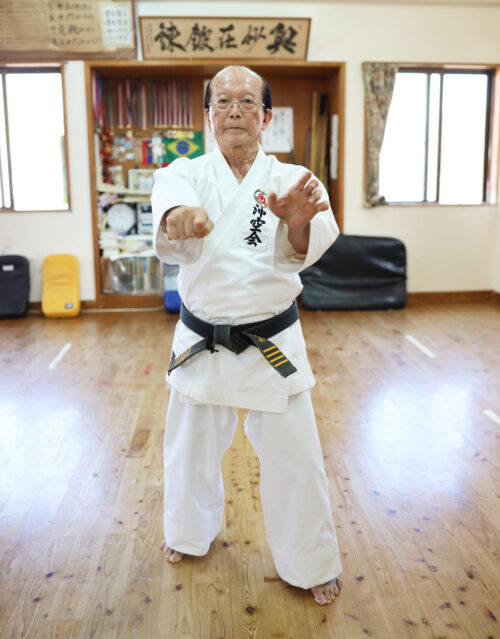
<小拳 Shoken>
Uechi-Ryu often punches with a Shoken (ipponken). The technique is achieved by using the protuberance made by flexing the index finger at the second joint. It should be targeting a vital point. If you hit the ribs, it will pierce the gap between them and damage the internal organs.
──What is the biggest difference between competitive karate and Uechi-Ryu?
-TOBARU SENSEI In Sport-Karate, kumite is ruled by control, and during a kata, the techniques must pause at regular points of the kata. This usually impresses the referees.
Uechi-Ryu is about contact (atejiai 当て試合). This is precisely why we are training our bodies to take pain. We perform our kata with the true intention to hit a target. In addition, Uechi-Ryu uses fingertips, toes, and sho-ken (also called “small fist” like ippon-ken), so the kicks and punches are as sharp as stabbing with a spear.
──”A strike that pierces rather than just impacts a surface”… This is rarely seen in competitive karate?
-TOBARU SENSEI A classic punch or kick doesn’t belong to the basis of our Karate, but a small fist (sho-ken小拳) or sokusen geri 足先蹴りis what we normally learn to do. If these techniques hit the face or the throat at a vital point, that’s the end of the fight. Therefore, in kumite, none of us use such techniques. These techniques are practiced in a kata called Sanchin 三戦, and are further trained by hitting various things such as sandbags or the makiwara.

<足先蹴り Sokusengeri>
Using his well-trained toes, the practitioner usually aims to kick at the abdominal vital points, with the intention of piercing through, like a spear would do. Seeing how 3 strong wooden boards are pierced with such a precision, it can therefore be compared to a powerful knife stroke.

<拡大図 Enlarged view>
Form a spear shape by bending the first joint of the toes and kick from the big toe.
Olympics and karate
──What do you think about karate becoming an Olympic event?
-TOBARU SENSEI I think that is a wonderful thing for “Sport-Karate”, but Okinawa doesn’t have the ambition to imitate the Olympics for its Karate.
For the past three years, we have been unable to conduct our tournaments because of the coronavirus, but Uechi-Ryu has always traditionally held a world tournament every year. A large number of members come from all over the world to compete and exchange techniques. If you watch our competition, you will understand what Uechi-Ryu is like.
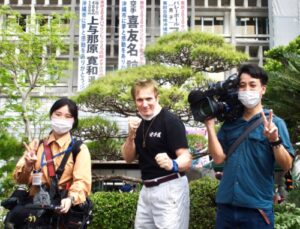
A picture of Daniel Sensei being interviewed on TV in Okinawa.
-DANIEL SENSEI The Tokyo Olympics had given the hope to elevate Karate to the level of other fighting sports. Unfortunately, Karate will not be invited to Paris in 2024, despite it is said that there are more than 130 millions Karate practitioners in the world. It seems that the Karate-world has always been divided because of various problems caused by differences in their styles, organizations, and philosophies.
A solution would be to create two distinct federations. One for Sport-Karate, with competitions and one for traditional Karate-Do.
Separating the two philosophies in order to allow them to coexist peacefully. “Separation” does not mean discrimination and forbidding interaction. It is quite possible to switch from Sport-Karate to Karate-Do and vice-versa! I myself went from different martial arts; Savate, Karate-Do, Kick Boxing and even Ninjutsu and back to Okinawa Karate and then back to kickboxing and now doing “My own Karate for health”.

<knee kick from Jyuji-uke>
Daniel Sensei demonstrates one of the representative techniques of the Shotokan style. Blocking a front kick with a Jyuji-uke (1), grab the opponent’s collar with crossed hands (2), and pull forward while kicking with a right knee into the plexus (3).
Towards the future of karate
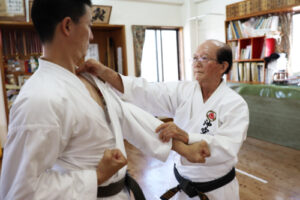
<鶴嘴拳 Kakushiken>
As the name suggests, Kaku (crane) Shi (beak) Ken (fist) is a thrust from above, targeting the vital part behind the collarbone, like a crane would do. The “Kakushiken” technique is done with the third joint of the four fingers bent at a right angle.
──Lastly, please tell us about your future prospects.
-TOBARU SENSEI In my practice, I would like to continue to protect and pass on the teachings that have been handed down to me, from long ago.
“If you focus on Sanchin 三戦and connect it to the other kata, you will become good at both kata and kumite.”
As for Okinawa, if Sport-Karate and Okinawa traditional Karate develop together, I think it will become more active in terms of international exchange. World competitions will continue to be held at the Karate Kaikan, and many people from overseas will visit Okinawa and will hopefully bring back to their respective countries what they have learned here.
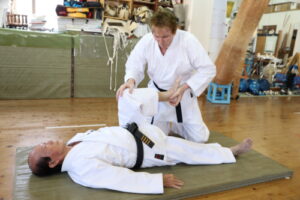
<Karate and body maintenance>
Daniel Sensei is doing body maintenance for Hanshi Tobaru. The different techniques incorporate science, so that the karateka becomes more efficient and healthier.
-DANIEL SENSEI As far as I am concerned, I have two goals.
One is to incorporate health and physical sciences into Karate. Both Karate-Do and Sport-Karate suffer from great ignorance about the body.
Knowledge of anatomy and physiology can make karate more effective and much healthier for all. Most of my friends and I, are suffering from serious body damages and even handicaps, due to our past teacher’s ignorance. Many people believe that science is the enemy of traditions, but it’s absolutely not true! The basic techniques and spirit of Karate can remain the same, but some intellectual concepts and a factual vision need to be brought to this art. For example, your feet, your knees, and your hips need to be in a certain anatomical position to maximize the potential of your ligaments, tendons, muscles and nervous system. This is more important than aesthetic concerns.
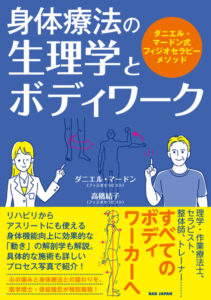
『身体療法の生理学とボディワーク』(The Physiology of Somatic Therapy and Bodywork)
(Co-authored by Daniel Mardon and Yuko Takahashi)
Now on sale from BAB Japan!
Deceived by the difficulty to perform well and not to fit into the mold of our champions, many people abandon or prefer focusing on the mystical side of karate. There is a Karate for every “body” and not only for a few young healthy athletes… Karate is not about perfection, but about winning!
My second goal is to create peace between the different styles and organizations. With a better administration and more body-science, people will become more tolerant about Karate. They should see it as a great and fun exercise that helps them with their health, postures and even rehabilitation.
Practicing Karate for protecting our body and to develop self-esteem, is often the basic reason why our ego is driving us to Karate. It is quite OK and we should accept that Karate can serve us as a mirror that reflects our fears and passions.
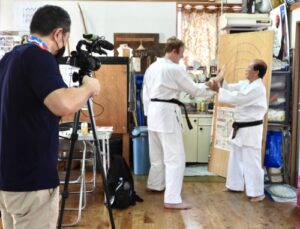
A long time ago, Tobaru Sensei created a board with circles of different sizes to teach to his students (of all sizes), that very same circular block we know from the movie “Karate Kid”. That block, attached to the words “Wax-on/Wax-off” became a universal trademark for the people who saw the movie. On the photo, Daniel Sensei enjoys reproducing the scene from the movie and playing “Daniel-san” learning from his Okinawan Sensei, this now legendary circular block.
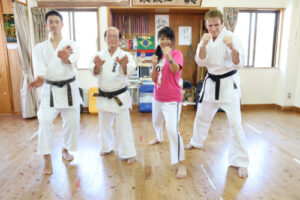
From left to right: Shihan Atsushi Hamada, (Tobaru’s assistant and 2nd time gold medal Okinawa Karate World Tournament Uechi-Ryu/adult), Hanshi Tobaru, Mrs. Yuko Takahashi-Mardon (who is also a professional physiotherapist) and Daniel Mardon Sensei.

